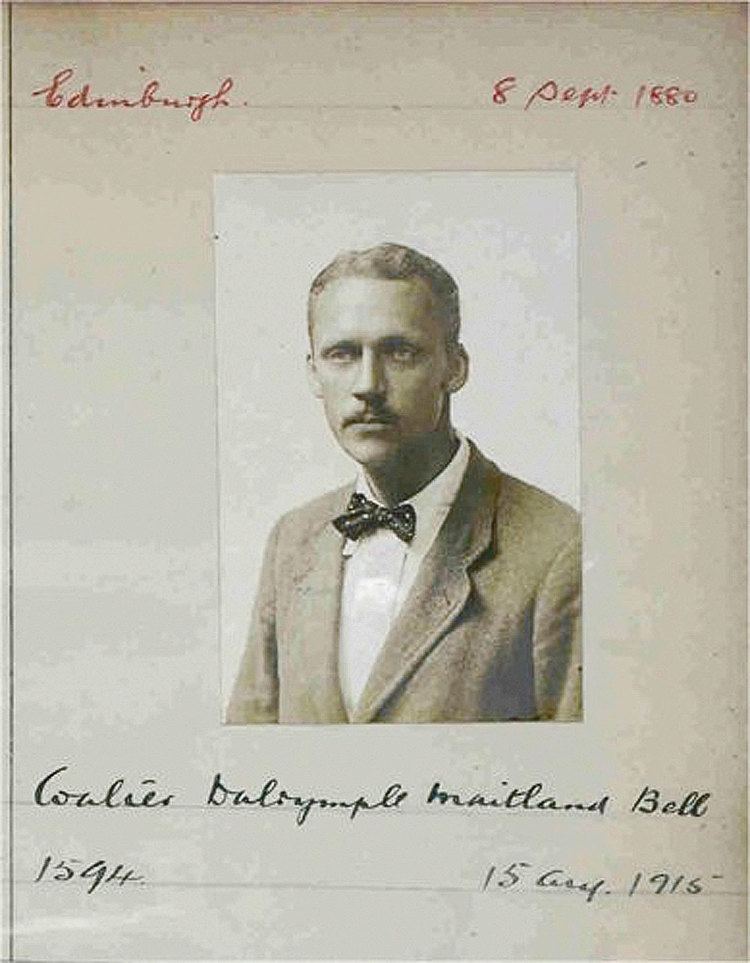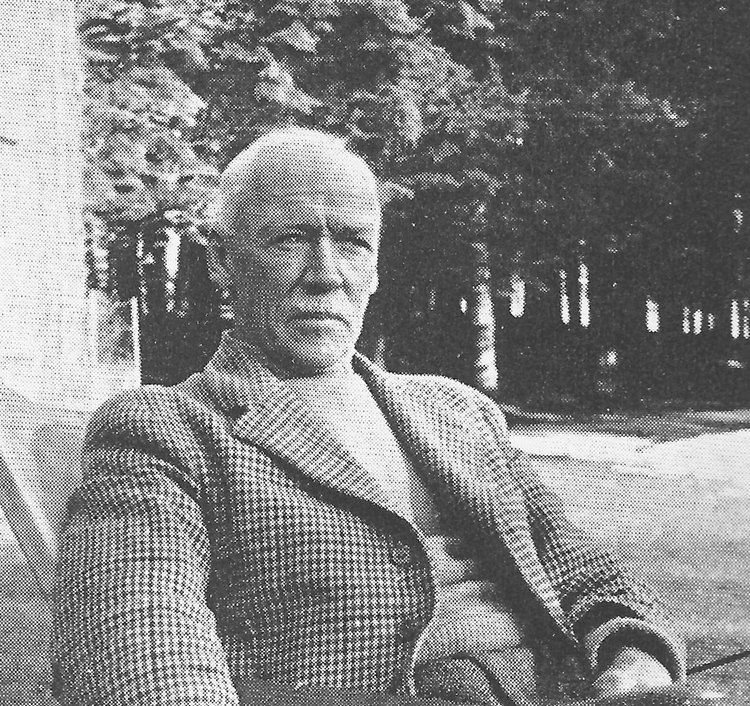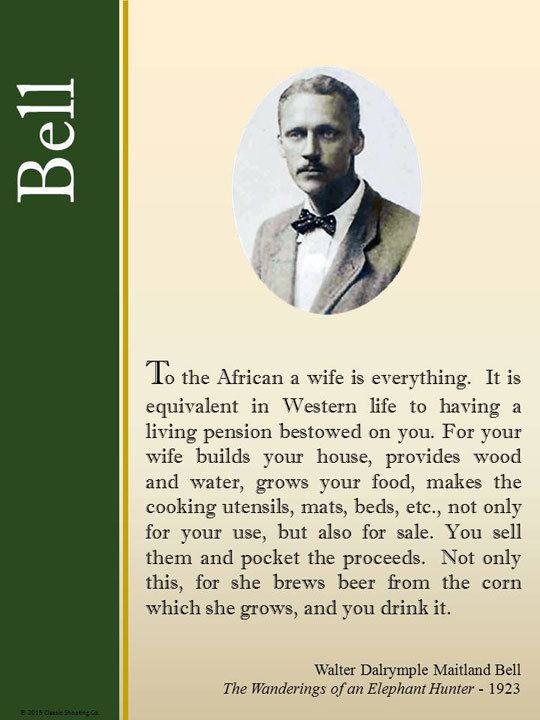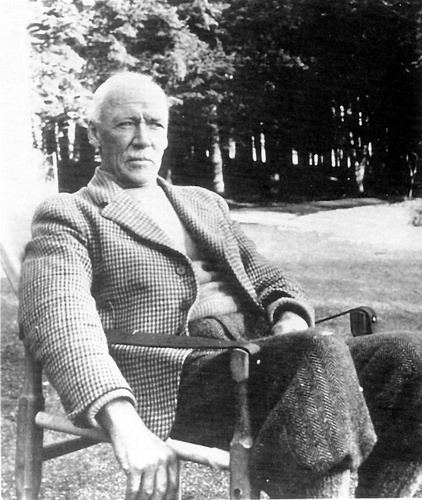Nationality Scottish Died June 1954 Role Writer | Name W. M. Citizenship United Kingdom | |
 | ||
Pen name W.D.M. Bell (Karamojo Bell) Occupation big game hunter, adventurer, soldier and aviator Genre autobiography, travel, adventure Books The Wanderings of an Elephant Hunter, Karamojo safari | ||
Walter Dalrymple Maitland Bell (1880–1954), known as Karamojo Bell, was a Scottish adventurer, big game hunter in East Africa, soldier, decorated fighter pilot, sailor, writer, and painter.
Contents
- Early life
- Yukon gold and the Boer War
- Big game hunter
- World War I
- Later years
- Marriage
- Biography
- References

Famous as one of the most successful ivory hunters of his time, Bell was an advocate of accurate shot placement with smaller calibre rifles, over the heavy large-bore rifles his contemporaries used for big African game.

He improved his hunting skills by the dissection and study of the skulls of elephants he shot. He perfected a technique of shooting elephants from the extremely difficult position, diagonally behind the target; this shot became known as the Bell Shot.

Although chiefly known for his exploits in Africa, Bell also traveled to North America and New Zealand, sailed windjammers, saw service in South Africa during the Boer War, flew in the Royal Flying Corps in East Africa, Greece and France during World War I.
Early life
Bell was born into a wealthy family of Scottish and Manx ancestry, on the family's estate named Clifton Hall, (today a school) in Linlithgowshire, near Edinburgh in 1880. Walter was the second-youngest of 8 children. His mother died when he was two years old and his father died when he was six. His father Robert Bell owned a successful business in coal and shale oil and the Bell family resided in their stately home near Broxburn, as well as owning the surrounding estate and other country properties.
He was brought up by his elder brothers but ran away from several schools, and he once hit his school captain over the head with a cricket bat. At the age of 13 he went to sea, and in 1896, at the age of 16, hunted lions for the Uganda Railway using a single-shot rifle chambered in .303 British.
Yukon gold and the Boer War
Bell convinced his family to back him for a trip to Africa, where he obtained a job shooting man-eating lions for the Uganda Railway at the age of 16. Afterward, Bell traveled to North America, where he spent a short time panning for gold in the Yukon gold rush and earned a living by shooting game to supply Dawson City with meat. His partner cheated him of his earnings. In order to return to Africa he joined the Canadian Mounted Rifles seeing service during the Boer War. Bell was captured when his horse was shot from under him, but he escaped and managed to get back to British lines.
Big game hunter
After the Boer war ended in 1902, Bell remained in Africa becoming a professional elephant hunter. Over sixteen years spent in Africa, he hunted elephants for their ivory in Kenya, Uganda, Abyssinia, Sudan, the Lado Enclave, French Ivory Coast, Liberia, French Congo and the Belgian Congo.
He became known as "Karamojo" Bell (Sometimes spelt Karamoja) because of his safaris through this remote wilderness area in North Eastern Uganda.
Bell shot 1,011 elephants during his career; all of them bulls apart from 28 cows. He is noted for using smaller calibre bullets rather than the heavy recoiling, larger calibre bullets that were popular with other big game hunters. Around 800 of his kills were made with Rigby Mauser 98 rifles chambered for the .275 Rigby (using the standard military 173 grain FMJ loading), which were considered by most other hunters to be too small for elephants, and which today are not legal for African game; Bell preferred smaller calibers because, besides being lighter rifles to carry, they recoiled less and therefore are quicker to the second shot. Bell found that German and English military ammunition was the most reliable which encouraged him to use the smaller calibers. His favourite rifles were a bespoke Rigby-made 7x57 with which he shot the majority of his elephants, a 'wand-like' Mannlicher–Schoenauer 6.5×54mm carbine, which he abandoned due to failure of the available ammunition, a Lee–Enfield sporting rifle in .303 British and Mauser rifles chambered in .318 Westley Richards. As 'the Bell Shot' involves shooting through the mass of the Elephant's skull, he insisted on using military full metal jacket bullets weighing from approx 173 to 250 grains, rather than the 400+ grain soft lead bullets popular at the time He particularly praised a Mannlicher M1893 rifle chambered in 6.5×53mmR supplied by George Gibbs that he used for most of his meat hunting in the Karamojo. On one occasion he managed to kill a small herd of 23 African forest buffalo using a .22 Hi-power 5.6×52mmR rifle. He disliked the double rifles considered archetypal for the African hunting of his time due to what he considered recoil detrimental to accuracy. Bell used the brain shot extensively wanting to kill elephants quickly before the herd became restless or took flight.
He mastered an oblique shot from the rear which was angled through the neck muscles and into the brain. This difficult shot has become known the "The Bell Shot" on elephant.
After World War One he began to use the .318 Westley Richards calibre, observing that his 'inexplicable misses' then stopped.
The most elephants he shot in one day was 19. The most bull elephant killed for their ivory in one month was 44. The largest amount of money made from ivory taken in a single day was 863 pounds sterling. He wore out 24 pairs of boots in a year and estimated that for every bull taken, he had walked an average of 73 miles (117 km).
WDM Bell has become famous for his superb marksmanship. He was once witnessed shooting fish jumping from the surface of a lake, and he wrote of shooting flying birds out of the sky with his .318 Westley Richards rifle, in order to use up a batch of faulty ammunition.
In addition to elephant, Bell had to supply his porters and native African followers with meat and also hides, for their own use and also to trade for other supplies. He shot over 800 cape buffalo with his small calibre rifles, as well as countless other plains game, including rhinoceros, and lions. Bell preserved a good working relationship with the native African peoples where he hunted, trading cattle for information as to where he could find good numbers of bull elephant. He believed that this co-operation with the local tribes was the main reason for his great success as an elephant hunter. He hunted in the warlike Karamojo area for five years without the killing of a single African in self-defence becoming necessary.
One of Bell's closest African companions while hunting the Karamojo region was a Karamojoan named Payale, a member of a local tribe. They hunted together over several safaris in the region, and Bell accorded him great respect. Another of Bell's hunting companions was New Zealander Harry Rayne, who accompanied him on a safari to Sudan and the Karamojo in 1907, and who later become District Commissioner in British Somaliland where he became the official responsible for apprehending ivory poachers. WDM Bell was also a lifelong friend of the American hunter Gerrit Forbes, (cousin of Franklin Roosevelt and later a friend of gunwriter Elmer Keith) who accompanied him on three safari's for elephant between 1907 and 1913.
WDM Bell was one of the 'gentlemen adventurers' that hunted the lawless Lado Enclave after Belgium withdrew from the region following the death of Leopold the Second in 1909, and prior to the territory becoming part of Sudan.
His preferred sidearm was the Mauser C96, equipped with a shoulder stock and chambered in the powerful 9mm Mauser Export calibre, which when used against human targets, "kept them dodging for 400 or 500 yards" according to Bell. Bell also purchased a Colt 1911 pistol in 1913.
World War I
At the outbreak of World War I, he was hunting in the French Congo and immediately headed back to England and began to learn to fly. He enlisted in the Royal Flying Corps, becoming a reconnaissance pilot in Tanganyika (present day Tanzania). It is reputed that in the early days he sometimes flew without an observer so that he could take pot-shots at the enemy with his hunting rifle. Later, he became a Flight Commander in Europe flying Bristol fighters.
Bell was the first in his squadron (47) to score an air victory when he shot down a German two-seater aircraft over Salonika on 23 December 1916. He shot down a German Albatross fighter with a single shot, after which his machine gun jammed, and once shot an aircraft down with a machine gun that did not have its sights aligned with the bore. With his observer Lieutenant R. M. Wynne-Eyten, Captain Bell shot down a French Spad by mistake, although the French pilot survived unscathed.
WDM Bell was Mentioned In Dispatches for the first time in 1916. By the end of the war he had received this distinction five times. He was decorated with the Military Cross by General Smuts, and received a bar to his MC for service in Greece and France. Bell was discharged in 1918 for medical reasons (stated on his discharge papers as 'nervous asthma') and was permitted to keep his rank. Finishing the war with the rank of Captain.
Later years
After a period of time recuperating from illnesses contracted during the war, he returned to elephant hunting, shooting in Liberia, on the Ivory Coast and traveling far inland by canoe, making a trip of 3000 miles in 1921. On this expedition he was joined by his comrade from the Royal Flying Corps, R. M. Wynne-Eayten. His last safari was an automobile expedition through the Sudan and Chad with Americans Gerrit and Malcolm Forbes, of which he later remarked that 'little hunting was done'. Rather the aim was to travel as far and as fast as possible with the vehicles. After this expedition Bell did not return to Africa. Although he intended to travel by air to Uganda for a last elephant hunt in 1939, his plans were interrupted by the start of World War Two.
Bell retired to his 1,000 acre highland estate at Garve in Ross-shire, Scotland, named "Corriemoillie", with his wife Katie (daughter of Sir Ernest and Lady Soares) to whom he had become engaged during World War I. He published two books about his exploits in Africa, illustrated with his own sketches and paintings. 'Wanderings of an Elephant Hunter' which was serialised in Britain's Country Life magazine, 'Karamojo Safari', and several articles about aspects of shooting and firearms in the NRA's 'American Rifleman' in the USA. His third book Bell of Africa was published posthumously.
Bell and his wife Katie spent their later years sailing competitively. They commissioned the first steel hulled racing yacht Trenchmere (37 tons) in Scotland in 1934 and sailed her in transatlantic ocean racing until the outbreak of World War Two. He also stalked red stags in the Scottish hills with a Winchester Model 54 chambered in the .220 Swift cartridge, which he wrote articles eulogising its superior effect on deer due to its high velocity.
After suffering from a heart attack in 1947 which limited his activities, Bell spent his last years on his estate. Only a few days after posting the manuscript for his last book, Bell of Africa, Bell died of heart failure on 30 June 1954.
Marriage
In 1917 he married Kate Soares, sole daughter and heiress of Sir Ernest Soares (1864-1926), of 36 Princes Gate, London, and of Upcott House in the parish of Pilton, near Barnstaple in North Devon, a solicitor and Liberal Party Member of Parliament.
